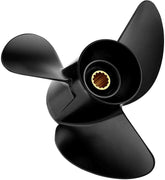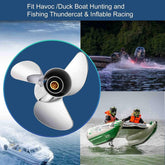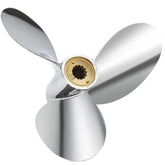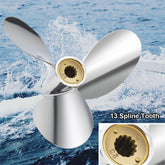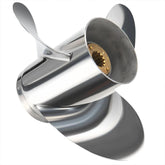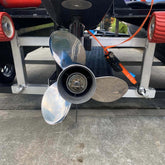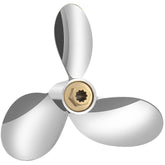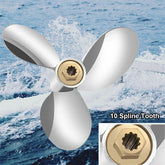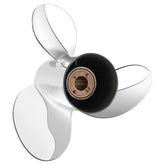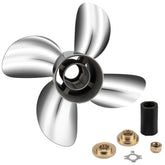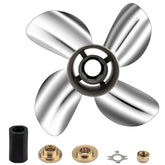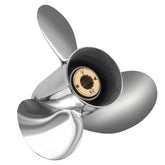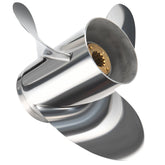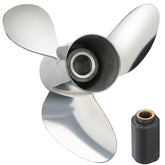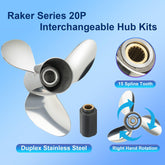Best Replacement Boat Propellers for Mercury and Yamaha Outboards
I spend more days on ramps and on tournament lakes than behind a desk. The single most common fix that makes a boat feel noticeably better is not a new engine or hull modification. It is the right propeller, matched to the real load you carry and tuned on the water. This guide is written like a shop conversation. It shows exactly how I diagnose fit issues, test props, decide between aluminum and stainless, and where to order parts and tested replacement props that fit Mercury, Yamaha, Honda, Suzuki, Volvo, and Tohatsu engines.
If you want to see how modern propellers are made and why manufacturing tolerances matter, read How Boat Propellers Are Manufactured.
Why a well-chosen replacement prop matters more than brand alone
A lot of boat owners assume brand is everything. Brand matters for quality control and hub systems, but a properly matched prop that is manufactured to tight tolerances and dynamically balanced will often outperform a stock prop that is the wrong pitch or blade area for your real world load.
A correctly chosen prop will
-
shorten time to plane and reduce fuel consumption during acceleration
-
place the engine at its recommended wide open throttle RPM for durable power delivery
-
reduce vibration and throttle hunting by matching blade area and balance to the lower unit
-
improve towing feel and low speed control with the right blade count and cupping
If you already know what to buy, jump to the Boat Propeller Online store. If you want engine-specific choices, start at propeller for Yamaha or propeller for MERCURY. If you run Suzuki, Honda, Volvo or Tohatsu see the corresponding collections for fast matches.
The five facts you must confirm before buying any replacement prop
A product page that only says fits Mercury or fits Yamaha is not enough. Do these five checks every time.
Engine make, exact model and model year as shown on the transom tag
Gearcase code from the transom tag because different gearcases use different spline counts and hub styles
Spline count and hub type such as Flo-Torq elastomer insert or splined bore
Rotation which is right hand left hand or counter rotating for twins
Washer and spacer order because incorrect sequence can cause hub slip
If the transom tag is unreadable remove the prop and photograph the hub and splines. Upload those photos to the seller before you buy. On the VIF product pages the compatibility matrix lists gearcase codes and spline counts so you can match SKU to your engine.
Practical differences between Mercury and Yamaha hubs and why they matter
Mercury often uses Flo-Torq elastomeric insert hubs on many gearcases. Flo-Torq isolates shock and provides replaceable inserts. Yamaha frequently uses solid splined bores with specific spline counts. A prop seller that claims compatibility should list the exact spline count and hub style for each SKU.
What that means for you
-
If your gearcase uses a Flo-Torq insert, verify the replacement prop supports the insert style.
-
If your engine uses a splined bore, match the spline count exactly.
-
For twins check rotation because counter rotation on paired engines must be correct.
When shopping, use propeller for Yamaha or propeller for MERCURY to find SKUs that list hub compatibility. For other brands use propeller for Honda propeller for Suzuki propeller for Volvo and propeller for Tohatsu.
The tuning rules that actually move the needle
Pitch is the primary tuning lever
Pitch determines whether the engine will reach its recommended wide open throttle RPM under your normal load. If WOT RPM is too low reduce pitch. If WOT RPM is too high increase pitch.
Diameter controls low end thrust
Larger diameter moves more water per revolution and improves low RPM bite and cavitation margin.
Blade area and blade count trade top speed for bite
More blade area or more blades increases hole shot and planing ability under load. Fewer blades reduce drag and favor top speed on light boats.
Cupping and rake are functional adjustments
Cupping increases low RPM bite and resists ventilation. Rake affects bow lift and planing behavior.
Slip gives objective feedback
Compute slip on the water to quantify pitch fit. Aim for roughly ten to twenty five percent slip for typical planing hulls with your usual load.
Two formulas to keep on your phone and use on the water
Theoretical speed in miles per hour equals pitch in inches times RPM divided by 336
Slip percentage equals one minus GPS speed divided by theoretical speed times one hundred
Use slip and WOT RPM together to decide changes. If WOT RPM is outside the engine maker’s band, change pitch. If planing is slow while WOT RPM is correct, increase blade area or try a four blade.
Starter prop recommendations by horsepower band
These are practical starting points that reduce guesswork. Always verify the SKU lists your engine and gearcase code.
Kicker engines five to fifteen horsepower
Start with an 8 by 8 three blade aluminum as a baseline.
Small outboards twenty to forty horsepower
Start with a 9 by 10 three blade aluminum for runabouts and jon boats.
Midrange outboards fifty to ninety horsepower
Start with an 11.5 inch diameter by 15 inch pitch stainless baseline. Bring an aluminum spare and a four blade option for testing.
One hundred fifteen to one hundred fifty horsepower rigs
Start with 14 by 19 stainless for speed and a four blade for loaded planing.
One hundred seventy five to three hundred plus horsepower boats
Test 15 to 17 inch diameter props with 19 to 25 inch pitch. Evaluate cleaver and high rake variations for high RPM runs.
If budget allows order the OEM baseline plus one inch lower pitch or a four blade. Factory direct stainless pricing makes this testing strategy realistic. For fast shopping use the Boat Propeller Online store and the hot selling collection.
Aluminum or stainless how to choose without the fluff
Aluminum pros and when to use it
Low cost sacrificial spare for shallow ramps and debris prone launches. Aluminum bends before transferring excessive energy to the lower unit.
Aluminum cons
Thicker blade sections lower peak efficiency compared with stainless.
Stainless pros and when to use it
Thinner more hydrodynamic blade sections, measurable top end and cruise efficiency gains, better edge retention for frequent use.
Stainless cons
Higher upfront cost and transfers impact energy to the lower unit more directly. Carry an aluminum spare for shallow water.
VIF offers both materials and lists material and hub compatibility on each product page so you can buy a stainless daily prop and an aluminum trailer spare in one order.
How to run an on-water test that produces repeatable data
Preparation is everything. Follow this sequence and you will make confident tuning decisions.
Prepare the boat
Remove hull growth set trim tabs to your normal running position fill the tank to typical level and load the boat with the people and gear you normally carry.
Warm the engine
Run the engine to operating temperature because cold numbers are misleading.
Run two to three wide open throttle passes
Use consistent conditions and average GPS speed and tach readings for the passes.
Compute theoretical speed and slip
Use the formulas above and record results for each pass.
Interpret and act
If WOT RPM is below the recommended band drop pitch by one inch and retest. If WOT RPM is above the band increase pitch and retest. If the boat will not plane but RPM is in the band increase blade area by switching to a four blade or a cupped three blade.
Iterate one inch pitch changes and a blade count swap until WOT RPM slip and planing feel are right. Ordering two props up front saves time and reduces returns.
Diagnosing and triaging common failures
Immediate actions after a strike
Stop the engine shift to neutral and photograph blades hub splines and the lower unit. Photographs speed up shop estimates warranty claims and support via live chat.
Check lower unit oil now
Milky oil or metal flakes mean internal damage or water contamination. If you find either do not run the engine and tow to a service shop.
Symptom decode for rapid diagnosis
Engine revs but boat does not move equals spun hub or stripped splines.
Vibration at cruise equals bent blade or imbalance.
Grinding noises and metal in oil equals gearset or bearing failure.
Loss of top speed with normal RPM equals blade deformation or heavy fouling.
DIY triage steps if you are comfortable
Remove the prop inspect the elastomeric hub replace inserts if shredded measure prop runout on a bench and straighten small aluminum bends then have the prop dynamically balanced.
When to call a professional
If splines are stripped the shaft is bent or stainless is cracked call a professional immediately. Repair costs can rise quickly if internal components are run after damage.
Keep a hub insert kit and aluminum spare on the trailer. That simple preparedness prevents most weekend failures.
Why manufacturing quality and balancing matter for replacements
Small differences in pitch finish and balance produce noticeable differences on the water. CNC finishing and dynamic balancing yield predictable results across parts. Factory direct manufacturing with documented quality control reduces variation and often lowers cost compared with OEM stainless. To understand these steps and why they matter read How Boat Propellers Are Manufactured. For an overview of the company and product lines visit the boat propeller manufacturer page.
How to use manufacturer selector tools effectively
Manufacturer prop selectors from Mercury and Yamaha are useful starting points. Use them to find the OEM baseline and record the stock diameter pitch blade count and gearcase code. Order the baseline for guaranteed fit then also order one inch lower pitch or a different blade count and test both with your normal load.
Your actual load hull condition and trim determine the final choice. The selector cannot know that so the on water test is the final judge.
Exact steps to order the right prop from VIF and reduce returns
Pull and photograph the old prop and transom tag data including the gearcase code.
Go to the Boat Propeller Online store and use the compatibility matrix on the product page to find SKUs that list your engine model and gearcase code.
If anything is unclear upload photos to live chat for verification. VIF staff will confirm spline count hub type and rotation before you checkout.
Add the baseline prop plus a one inch lower pitch or four blade variant and include an aluminum spare to the cart. Select U.S. warehouse shipping for fastest delivery.
Install the baseline and run the on-water test routine. Keep packaging until you are satisfied in case you need to return under warranty.
Direct engine collection links make it fast to shop: propeller for Yamaha propeller for MERCURY propeller for Suzuki propeller for Honda propeller for Volvo propeller for Tohatsu. For tournament and popular models check the YBS propeller chopper propeller and vengeance propeller collection.
Common buyer traps and how to avoid them
Don’t buy a prop that only says fits Mercury or fits Yamaha without gearcase code and spline count.
Don’t assume rotation; twins frequently use counter rotation.
Don’t ignore thrust washer and spacer order. Wrong sequences can lead to hub slip.
Don’t test on an empty boat. Always test with your normal load and gear.
If you want proven starter choices, use the hot selling collection for recommended models and configurations.
FAQ that customers ask at the ramp
Will a compatible prop damage my Mercury lower unit
Not if you select the correct SKU that matches gearcase code and spline count. Damage typically comes from impacts wrong washer order or contaminated oil not from a properly matched prop.
How do I compute prop slip on the water
Use the formulas above. Compute theoretical speed then compare GPS to get slip percentage. Aim for roughly ten to twenty five percent on planing hulls.
Should I buy aluminum or stainless
Use stainless for daily performance and aluminum as a sacrificial spare. Modern factory direct stainless pricing makes testing multiple stainless options realistic.
How do I confirm fit before I buy
Photograph the transom tag and hub and use the compatibility matrix on the product page. Upload photos via live chat for verification.
Where can I buy tested replacements fast
Start at the Boat Propeller Online store and choose the engine-specific collections for Yamaha Mercury Honda Suzuki Volvo and Tohatsu.
Real-world checklist to get tuned and stay on the water
Photograph your transom tag and old prop hub.
Confirm engine model year and gearcase code.
Order the OEM baseline and one inch lower pitch stainless or a four blade variant plus an aluminum spare from the Boat Propeller Online store.
Run two to three wide open throttle passes with your normal load compute slip and confirm WOT RPM is in the engine maker recommended band.
Keep packaging and photos until you are satisfied and use live chat for verification if anything looks off.
Keep a spare aluminum prop and a hub insert kit on the trailer to avoid weekend failures.
If you want help choosing the exact SKU paste your transom tag data and a photo of the old prop hub into VIF live chat and support will confirm the correct product before you check out.


